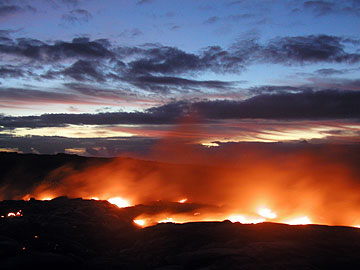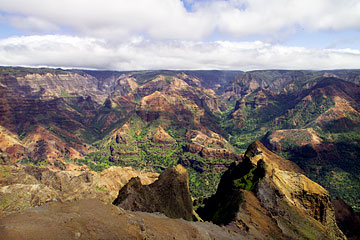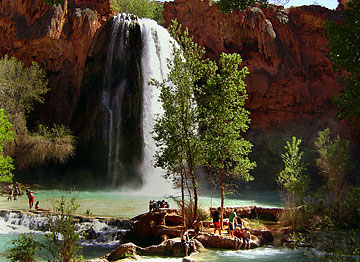
|
Facts of the Matter
Richard Brill
|

U.S. GEOLOGICAL SURVEY
Volcanic activity releases tremendous amounts of heat as it wedges techtonic plates apart.
|
|
Blazing pair creates Earth's landscape
WE LIVE between two fires. Ninety-two million miles above us, the sun's surface is 10,000 degrees Fahrenheit. A mere 4,000 miles beneath our feet, Earth's core is the same temperature.
These two fires power two heat engines that drive all geological processes on Earth.
We can measure the sun's temperature directly, but to get information about temperatures deep in the Earth we must use indirect methods and then assemble their results to estimate the temperature of the core.
From studying seismic waves that are refracted, reflected or absorbed by it, we know that the core is solid and surrounded by a liquid outer core.
In the laboratory, we can put iron under intense pressure and see how its properties change. From that, we can make a prediction. Right or wrong, it is in the ballpark, and the best we can do at present.
We know that it gets hotter with depth because the temperature increases steadily downward in bore holes and mines, and molten rock erupts from volcanoes.
The inner fire is Earth's natural nuclear reactor. Radioactive atoms of potassium, uranium, thorium, rubidium and others release nuclear energy that heats the surrounding rock.

STAR-BULLETIN / 2002
Waimea Canyon on Kauai, a prime example of erosion over millions of years.
|
|
Several of the radioactive elements have half-lives of more than 1 billion years, so there are still plenty of atoms left to generate heat even after more than 4 billion years of Earth's existence.
Convection transfers internal heat to the surface. This is the most effective method of heat transfer in the semi-solid rock. It also powers plate tectonics, which is the driving force behind volcanoes, earthquakes and folded mountain ranges.
Heat flows out of the ground everywhere in small amounts, but volcanic activity along the 40,000-mile mid-ocean ridge system releases tremendous amounts of heat as it wedges tectonic plates apart.
Earthquakes are a secondary method of heat transfer. When near-surface rocks fracture, they release elastic energy that was stored in the rocks as they were stressed by plate movements.
Great mountain ranges like the Rockies, Andes and the Alps are folded, faulted and distorted. These are the results of work done over millions of years by collisions of converging plates. Energy is expended to deform and fracture rocks buried tens of miles deep in Earth's crust and thrust them upward.
As the mountains grow upward, the external fire provides the energy to carve them into peaks and valleys.
The sun drives weathering and erosion using water as an agent. These destructive processes work together to counter the constructive forces of plate tectonics.
Water is a corrosive chemical that reacts with rocks to change their composition. It seeps into cracks in rocks and expands when it freezes. Running water in rivers and streams interacts with sediment in complex encounters trying to reach an equilibrium that is never achieved.
Weathering refers to any process that changes rock chemically or physically. Weathering facilitates erosion. Erosion is any process that lifts a rock fragment, regardless of size, from its original position.
Chemical weathering is a rearrangement of atoms within the rock, changing its mineral composition. Physical weathering breaks rocks into smaller pieces, increasing the exposed surface area.

LOS ANGELES TIMES
Running water is the principal agent of erosion.
|
|
As an effective agent of chemical weathering, water becomes slightly acidic and corrosive to rocks when it dissolves small amounts of carbon dioxide from the atmosphere.
As an agent of physical weathering, water expands when it freezes. Repeated freezing and thawing of water in cracks can wedge rocks apart over time.
Running water is the principal agent of erosion, a word that is often used generically to mean a condition in which the Earth's surface is worn away by the action of water and wind.
Normally, we think of moving something as a single action, but geologists break movement into three separate actions.
Erosion is picking up materials, transportation is moving them from one place to another, and deposition is putting them down again. The triage is because there are various ways of accomplishing each of the three actions under different circumstances.
For example, raindrops falling on a hillside may accomplish all three processes. The impact splashes and throws bits of soil outward in a small explosion. Some of the soil lands downhill from the impact point, so it is eroded, transported and deposited in a continuous action.
Likewise, mass movements such as landslides accomplish erosion, transportation and deposition in a sequential continuity.
Various types of mass movements carry rock fragments of all sizes downhill, but the process stops if the debris is not removed.
Running water carries away the debris. By efficiently exploiting its complex dynamics, a stream can erode a valley that is hundreds of times wider than the stream and thousands of feet deep.
A stream is actually a system of running water that contains both water and sediment, both of which are unpredictably variable. It is continually seeking equilibrium between the two and adjusts to changes by moving or storing sediment.
Erosion, transportation and deposition are reactions to a change in the speed of the water, the amount of water, the size of the sediment, and the amount of sediment.
During times of high rainfall or rapidly melting snow, a mountain stream that is normally only a babbling brook may swell to 100 times the volume of water that is moving 10 times faster than normal.
The maximum particle size that running water can erode or transport depends on the speed of the flow. In the mountains where the stream gradient is steep, huge boulders stand as a testament to the awesome power of water moving at high speed.
Downstream, the gradient decreases and the speed of the water decreases. Whenever the speed decreases, the stream deposits sediment grains by size, with the largest being deposited first.
As sediment moves downstream, the stream sorts it by grain size as the water slows and deposits grains ever and ever finer. When the speed of the water increases, it erodes and transports everything up to the maximum particle size for its speed.
With each change in its flow, the stream erodes, transports and deposits again and again, slowly moving sediments downstream.
The flow in any stream is as variable as the weather in its drainage area. Depending on climate, topography and distance, it may take a few years or hundreds of thousands of years for sediment to move from the mountains to the sea.
At the current rate, destructive processes driven by the external fire would have leveled all of the mountains and hills on the planet more than 100 times.
Without the constructive effects of the internal fire, there would be no landscape, and the planet would be entirely covered by ocean.
Together the two fires give Earth a landscape unlike any other planet we know of.
Richard Brill picks up where your high school science teacher left off. He is a professor of science at Honolulu Community College, where he teaches earth and physical science and investigates life and the universe. He can be reached by e-mail at
rickb@hcc.hawaii.edu.

